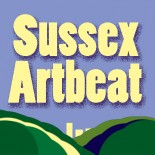Review – local, romantic and painterly influences in SHADOWS AND ECHOES – photography by Justyna Neryng | Corridor Gallery | from 7 October 2015
Russell Honeyman is delighted by painterly influences and local artists’ models at Justyna Neryng’s show of photography at Corridor Gallery in the London Road area of central Brighton, which opened yesterday 8 October 2015.
How sublime to find myself discussing whether the photography on show is more reminiscent of the painting of Caravaggio, or of the pre-Raphaelite school. Justyna is right of course, the creation of form in her new show of photography, owes much to the way she handles light and shadow, recalling work of the Italian master of chiaroscuro technique – Caravaggio. But the detached wonder in the expression and gesture of the models in the group called Ghost Dance is surely reminiscent of the pre-Raphaelite School?
“Ah,” says Justyna, “That would be Frankie”.
Justina is referring to the long haired model who has become iconic of the life drawing scene in Brighton. It is Frankie’s presence that lends these photographs the dreamy serenity of the romantic paintings of the English school of the late Victorian era – the pre-Raphaelites. She gazes out of frame, in a detached dream, looking perhaps at a beautific angel in the far distance. Her pose is reminiscent of Venus rising from the waves, and her hands conveniently protect her modesty.
Caravaggio was an Italian painter active between 1592 and 1610. His paintings combine a realistic observation of the human state, both physical and emotional, with a dramatic use of lighting. The pre-Raphaelites were active in the mid to late 1800’s, and also made great use of light, often painting directly onto a wet, white ground.
These painterly influences in style and content make great photos, and its interesting to consider the extent to which photography is influenced by painting. Readers of my column will know my thoughts on photography and painting – that we have left behind the era where we thought painting was made obsolete by photography, and entered a new era where photography influences painting, and painting influences photography in a symbiotic relationship. Painting uses photography not only as a reference for form and colour, but also for style and composition. Hyper-realist painters make a virtue of the artefacts found in photography, such as lens flare or the skin pores isolated by a narrow depth of field. Impressionists such as Degas used the awkward cropping of photography from life to create an un-posed feeling of immediacy. But the painter remains in charge, and these paintings contain more than photographs. Of the other hand, photographers have long been influenced by painting, not least in the use of light and dark, but also in colour.
The photograph of Ghost Dance, above, cannot do justice to the original on show. When viewed in life, the white pigments of the model’s body seem to be suspended as if they were actually in oil. I wondered if there is a white pigment in the print? Justyna did tell me if she used white in making the prints, instead told me she got the tonal effect by using a green filter. So here we have a photographer seeking the effect of a painter’s ‘limited palette’.
I guess the combination of pose and colour reminds us of classical paintings, and the knowledge that this is photography intrigues us. But its also about the subject matter, the female nude. Classical painters, and the pre-Raphaelites, often portrayed women in an adoring way, but they were mostly men and the woman can seem like objects for observation. It’s interesting and subtle, but I think women painting (or photographing) the nude, even in similar poses, often evoke a slightly different feeling – an empathy with the model, created by nuances of expression and gesture.
Justyna has another group of photographs on show at Corridor. This is group is called Childhood Lost, and shows a child in costume. A knight in shining armour, a girl in a feathered cloak. Again the strong lights and darks, but more colour. And the model in this group has different mood. Although it is a child dressing up, the costumes have an adult feel, and her face is sombre. It’s as if she is dressing up as an adult, an adult from a bygone era. There’s something of the twilight here. Makes me think of surreal graphic novels by Dave McKean. Or the oil paintings by Hove-based painter Kevin Hendley. The model in Childhood is Justyna’s daughter.
There are some beautiful prints of the works on show, on sale from about £40 if my memory serves me right. There’s also work on sale from other makers, and the gallery was doing a good trade in jewellery on the night.
https://www.facebook.com/corridorgallerybrighton
Corridor Gallery, 28 York Pl, Brighton BN1 4GU, tel: 07931 849347








Reblogged this on Art+ Brighton.